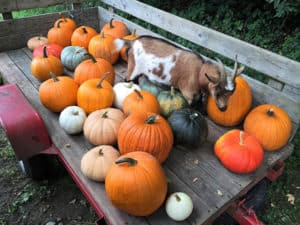By Vern Grubinger
Editor’s note: Vern Grubinger, who is based in the University of Vermont Extension office in Brattleboro, is the extension vegetable and berry specialist.
The pumpkin is an odd vegetable. The more popular pumpkins get, the less people eat them.
Everyone wants to carve a jackolantern, but few people make pumpkin pie anymore. In other words, the pumpkin was once a popular food but now it’s just another pretty face.
When Europeans arrived in the New World, pumpkins and other squashes were widely cultivated by Native Americans who boiled, baked and dried them for nourishment.

Farms, pumpkin patches and other venues offer a delightful array of pumpkin sizes, colors and shapes for sale.
Pumpkins are one of the oldest domesticated food plants. Seeds many thousands of years old have been found in the highlands of Mexico. Pumpkins come in all sizes and shapes. They’re in the cucurbit plant family that includes squashes and cucumbers, but there are different species of pumpkins. Cucurbita moschata includes pumpkins used for canning which tend to be oblong with tan skin. The jackolantern and miniature pumpkins are Cucurbita pepo. Cucurbita maxima are the beasts of the pumpkin patch, giant pumpkins.
Henry David Thoreau wrote about growing a pumpkin weighing 123 pounds in 1857. By 1893 the record was 365 pounds, at the Chicago World’s Fair. The 1,000-pound mark was reached in 1996 by a New York grower. Last year, a pumpkin in Italy weighed 2,703 pounds.
Pumpkins of any size start from a female flower. These open for a few hours in the morning, ready for insects to deliver pollen from a male flower. Managed honeybees and native, ground-based bumble bees and squash bees are common pumpkin pollinators.
Once pollinated, pumpkins grow rapidly. They’re ready for harvest when the skin is tough to puncture with a fingernail, and the seeds are ripe. Most pumpkins turn orange as they ripen, but there are varieties with blue, tan and white coloring.
The difference between pumpkins and other winter squashes is culinary rather than taxonomic.
Pumpkins are drier, coarser and strong-flavored compared to squash. They’re used in pies rather than served as a baked vegetable. They typically have a harder, more jagged stem, too.
The average pumpkin meets its demise in October or November for Halloween or Thanksgiving, as a jack-o-lantern or for dessert. The tradition of carving vegetables for Halloween was brought to America by Irish and Scottish immigrants, who previously used potatoes or turnips, but found pumpkins easier to carve. Halloween has its origins in an ancient Celtic event as well as All Saints Day, established by medieval popes.
The U.S. produces about 1.5 billion pounds of pumpkins annually. Much of that comes from Illinois for canning. In the Northeast, pumpkins are an important source of fall revenue for many diversified vegetable farms.
Pumpkins are fun, delicious and nutritious, too. Their orange color comes from beta-carotene, an antioxidant that converts to vitamin A in the body. One cup of pumpkin contains just 50 calories but has three grams of fiber and a lot of potassium. Pumpkin seeds are packed with protein, fiber, many minerals and healthy unsaturated fats.




